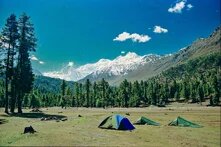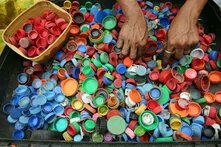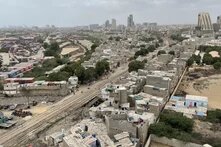
The recent surge in colossal projects unfolding in Pakistan’s vital port city have been hailed as transformative by those in power but can they be both inclusive and sustainable?

In the heart of Gwadar's historic Shahi Bazaar, at Kerimok Cafe, local fishermen, their futures uncertain, found solace in cheerful conversations over steaming cups of tea. For these fishermen, a visit to Kerimok Cafe has become an indispensable tradition after returning from their sea-faring endeavours. This cafe has transcended time, evolving from a relic of Gwadar's ancient heritage to a functional, refurbished establishment.
Seated on a bench in Kerimok Cafe, I was captivated by the fishermen's discussions. My gaze shifted towards the East Bay Express, the road that now seamlessly connects Gwadar Port to the Makran Coastal Highway. This road has evolved into a bustling hub of commercial activity emanating from Gwadar Port, where the ever-watchful presence of security personnel attests to its significance.
Gwadar, often referred to as the "Gate of the Wind," is a peninsula nestled amidst the embrace of the sea on three sides. Once a quaint fishing village, it has rapidly transformed into a globally recognised port city, courtesy of its association with the China-Pakistan Economic Corridor (CPEC). Gwadar is a naturally occurring deep-water port that gives it the nickname "Gateway to South Asia". It is located in the southwest coastal region of Balochistan and has maritime borders that open up to the Arabian Sea and the Persian Gulf.
Notably, Gwadar's historical roots can be traced back to its time as part of the Sultanate of Oman from 1783 to 1958. In a significant turning point for the city's development, the Government of Pakistan, under the leadership of Prime Minister Feroze Khan Noon, acquired Gwadar from the Sultanate of Oman in 1958 for 4 million pounds, marking a pivotal milestone in its evolution.
Local concerns and call for inclusivity
The recent surge in development and colossal projects unfolding in Gwadar have been hailed as transformative by those in power, with claims that the CPEC will usher in a multitude of employment and development opportunities for the city. Conversely, among nationalist circles, which comprise the local Gwadar residents and Baloch nationalist entities such as the Balochistan National Party (Mengal) and the National Party, who conduct political activities under the banner of Baloch nationalism, this whirlwind development is viewed as a detriment to the Baloch and the local populace. They contend that this rapid progress may not actually benefit the very people who call Gwadar home.
The local inhabitants of Gwadar are voicing their reservations, expressing the belief that the development initiatives and recent growth including some very important projects like the construction of the Gwadar East Bay Expressway, the establishment of the Pak-China Technical and Vocational Training Institute, the construction of the breakwater and the commencement of construction of the New Gwadar International Airport have not been adequately designed with their interests in mind. For instance, the construction of the Gwadar East Bay Expressway led to the compulsory resettlement of local residents, resulting in the loss of their primary sources of income. Concurrently, the Pak-China Technical and Vocational Training Institute is currently engaged in training the local population. However, before it can produce a substantial number of trained individuals, there has already been an influx of a significant number of outsiders, who have initiated their investments and involvement in the projects.
Local fishermen, in particular, find themselves disheartened, as their traditional fishing grounds face the prospect of being lost to development projects, potentially jeopardising their livelihoods in the absence of viable alternatives.
Zahid Dost, a PhD student at the University of Peshawar, specialising in CPEC research and its implications for the local population, highlights a pressing concern. Local residents are anxious that the significant influx of external investors and immigrants may jeopardise their language, culture and identity. Moreover, Dost underscores that with the arrival of a substantial number of external investors, the local population's traditional sources of income are at risk. The limited capacity of local residents to engage in large-scale investments puts them at a disadvantage in the emerging economic landscape. This predicament accentuates the immediate necessity for the government to formulate a comprehensive strategy that safeguards the employment and economic well-being of the local population, a crucial facet that is currently lacking in the development framework.
Additionally, the ongoing mega projects in Gwadar necessitate a skilled workforce. However, a notable shortage of technically proficient individuals among the local population inhibits their participation in these projects due to their lack of technical education. The establishment of the Pak-China Vocational and Technical Institute is undoubtedly a positive step forward, addressing a longstanding demand from local residents for technical education institutions in Gwadar. This initiative ensures that they gain access to the requisite technical knowledge, eventually enabling them to actively engage in projects related to the Gwadar Port and CPEC once a significant number of qualified locals are produced. Until this capacity is built, the presence of external investors and immigrants could potentially impact the income sources of the local population, as they may struggle to compete in the evolving economic environment.
Old City restoration project
The ancient civilisation and cultural heritage of any nation serve as mirrors of its culture and civilisation. The Old City Restoration Project in Gwadar is seen as a significant and positive endeavour by the Gwadar Development Authority (GDA). However, local residents are growing increasingly impatient due to perceived delays in its execution; the rapid pace of development has underscored the urgent need for the restoration of ancient monuments that were on the verge of collapse due to the ongoing projects. The Old City bears the imprints of various historical periods, including the Omani, British and Portuguese eras, and these monuments serve as tangible reminders of the nations that once governed Gwadar in the past. According to Mujeeb Ahmed Qambrani, director general of the GDA, the restoration project plays a pivotal role in modernising the Gwadar Old City Master Plan. As per his statement, progress is underway with the refurbishment and construction of 23 roads in various sectors of the old city, alongside various undertakings such as sewerage and water supply enhancements, school construction and renovation and the establishment of a cemetery.
Hafeez Dashti, the focal person for the GDA, affirmed that the Old City Restoration Project is actively ongoing, encompassing the revitalisation of every street and neighbourhood within the Old City. Upon the completion of this venture, Gwadar is poised to undergo a profound transformation, emerging as a place of entirely new and captivating aesthetics.
Preserving ancient cultural heritage
Local residents harbour concerns that the rapid development projects in Gwadar may threaten the city's rich cultural heritage, echoing both Omani and British influences. In 1783, Prince Saeed, having faced defeat in the war of succession, made his way to ‘Zak’, a village of the Merwari tribe, a Baloch community in Makran, via Kawada. There, he was warmly received by the "Khan of Kalat" and the tribe's chief, Daad Karim. The prince sought military support in his bid for the crown and throne, but the local chieftains, rather than involving themselves in Oman's internal affairs, offered him the territory of Gwadar under the condition that if he managed to regain his power, he would hand over Gwadar to the Gachki Sardars, as documented in the Balochistan Gazetteer.
The restoration of this heritage has long been a passionate plea from Gwadar's citizens. Nasir Rahim, a committed social activist from the region, emphasises that cultural heritage serves as a window into a nation's ancient culture and civilisation, representing a collective national treasure. This is precisely why, in response to the fervent demand of the local residents, comprehensive efforts to preserve and restore all these heritage sites, including those impacted by the development projects associated with the CPEC, have been set into motion.
Dashti notes that a comprehensive programme is underway to restore five of Gwadar's cultural heritage sites. Presently, efforts are focused on the rehabilitation of the Charpadgu building, Gwadar Telegraph and the Omani Port. The GDA has made the restoration of Gwadar's cultural heritage its foremost priority.
Archaeologist Imran Shabbir underscores that while it may be challenging to fully restore these historical assets to their original state, careful reconstruction and repair work can help preserve these invaluable national legacies for future generations.
Forced relocation of the locals
The Gwadar Expressway serves as the critical link connecting Gwadar Port to the Makran Coastal Highway. Due to the substantial volume of VIP movements and the extensive use of this route by cargo vehicles transporting goods from ships arriving at Gwadar Port from various countries, the residents of Dhor, a locality in close proximity to the expressway, have been relocated to Vishin Dhor. Additionally, to accommodate these developments, the population of Mulla Band, an adjacent area near Gwadar Port, has also been relocated to a newly established area known as New Town. Of particular concern is the community of Wadi Dhor, whose livelihoods are centred on salt-related businesses in the area. The displacement of these residents would have severe repercussions on their trade and economic stability.
Impact on boat building industry
The Padi Zar coast of Gwadar presently hosts a thriving local boat building industry, where skilled artisans craft boats using traditional methods. Iqbal, a craftsman with deep ties to this industry, highlights the significance of Padi Zar's location, which offers an ideal setting for boat construction, with easy access to the sea for launching finished boats. However, road construction on Gwadar's west coast, specifically in Padi Zar, threatens to uproot these boat builders.
According to GDA chief engineer Syed Muhammad, provisions will be made to allocate space near Mount Batil for boat builders aiming to secure their workspaces. However, boat builders remain sceptical about government assurances, fearing changes that could disrupt their traditional practices, making it hard for future generations to continue their craft. Additionally, VIP activities and impending evictions threaten their livelihoods and homes, causing anxiety among the approximately 2,000 individuals tied to this trade, who fear the impact on their way of life and job security.
Fishing locations under threat
A significant portion of Gwadar's population relies on fishing as their primary means of livelihood, their sustenance drawn from the depths of the sea. And the fishing community is among those most profoundly affected by the recent developments in Gwadar. For security reasons, small-scale fishermen face restrictions on their sea ventures, constrained to specific timeframes.
The construction of the East Bay Expressway (Demizar Expressway) and Marine Drive now occupies areas that were once prime fishing grounds for these local fishermen. Despite their prior use as fishing spots, these areas are no longer accessible due to security and other concerns, with the government having failed to provide a viable alternative. Moazzam Khan, technical advisor of WWF Pakistan, believes that the construction of breakwaters in Padi Zar holds promise for the fishermen, offering enduring benefits. He views recent development initiatives as a positive step for the local fishing community, enabling not only the marketing of locally caught fish on the international stage but also improving their access to a global array of markets.
However, local fishermen remain dissatisfied with the government's actions. While former Prime Minister of Pakistan Shehbaz Sharif announced the allocation of 2,000 engines for fishermen, only around 900 fishermen have received compensation of Rs.250,000 each, leaving many others in the fishing community with unaddressed concerns.
The ongoing construction along the coast is poised to inflict severe harm on aquatic life, resulting not only in escalated water pollution but also endangering the survival of numerous marine species. Gwadar based biologist Sudhir Baloch underscores the necessity for any construction to maintain a distance of 500 metres to 1 km from the coast to safeguard the marine ecosystem.
Regrettably, construction of roads along the Gwadar coast threatens the aquatic environment. Biologists warn that this coastal development and human intervention will pose substantial risks to marine breeding grounds. Given that the livelihoods of Gwadar's residents are intricately linked to marine life, this process is anticipated to imperil their economic stability. Without alternative sources of income, the local population faces the grim prospect of unemployment.
Wali Khalji, deputy director of the Balochistan Environmental Protection Agency, emphasises that when approving any development project in the coastal regions of Balochistan, comprehensive environmental protection plans are mandated and they must be strictly adhered to.
GDA’s deputy director of environment Abdul Rahim Baloch, however, says that two GDA sections are actively working towards a sustainable environment in Gwadar. The Plantation Section, in collaboration with the Gwadar Municipal Section, is engaged in tree and sapling planting across various areas of Gwadar. Notably, Abdul Rahim Baloch mentions that ninety percent of Gwadar's sewage water is recycled and channelled towards nurturing the plants and trees cultivated by the GDA.
Previously, Gwadar's sewage water was directly discharged into the Demizar and Padi Zar seas, causing water pollution. According to Abdul Rahim Baloch, this shift toward recycling represents a positive stride towards nurturing a sustainable environment.
Navigating opportunities amidst challenges
Though the ongoing development in Gwadar has presented its share of challenges for the local population, it has also ushered in a host of opportunities. Gwadar University, in conjunction with the Pak-China Technical and Vocational Institute, has made remarkable strides in the realm of education. Empowered by these educational and technical institutions, Gwadar's youth are better equipped to confront future challenges and tap into various employment avenues.
The development initiatives are set to create not only thousands of job opportunities but also exponentially raise the land values in the region while establishing a robust infrastructure. The Gwadar New International Airport stands as a beacon of progress, promising positive change in the days to come. With approximately $50 billion worth of projects under the CPEC, a considerable portion of which has already been completed, officials project that the remaining ventures will be finalised by 2030. This collective endeavor is poised to reshape the destiny of the people of Balochistan, including those in Gwadar.
Key CPEC projects in Gwadar
1. Gwadar East Bay Expressway:
This $140 million project is set to establish a vital link between Gwadar Port and the Makran Coastal Highway. The construction of this expressway not only secures the transportation route but also substantially reduces the travel distance.
2. New Gwadar International Airport:
Situated approximately 40 km from the city, the New Gwadar International Airport is currently under construction, bringing air travel accessibility to the region. This $230 million undertaking will be capable of accommodating large aircraft, enhancing the city's connectivity.
3. Pak-China Technical and Vocational Training Institute:
With a budget of $100 million, this centre will impart technical education and training to the local population, equipping them with the skills needed to participate in various mega projects, including Gwadar Port, in the foreseeable future.
4. Construction of breakwater:
This vital $123 million project aims to provide anchoring facilities for the local community's boats near the sea, bolstering maritime activities and livelihoods.
In addition to these initiatives, Gwadar is also slated to benefit from other projects encompassing electricity, water supply, sewerage lines and the construction of the Pak-China Friendship Hospital.
Conclusion and recommendations: Balancing Gwadar's development impact
The recent surge of development in Gwadar has introduced a range of challenges and opportunities that demand a thorough examination. On the positive side, this development has created job prospects for residents, leading to improved livelihoods for some through their participation in various small-scale endeavors. However, specific government initiatives have instilled apprehension among the local community, who are worried about the potential loss of their jobs and traditional ways of life. The compulsory relocation of people due to certain projects has intensified the negative economic impact on these residents.
Experts concur on the necessity of a comprehensive plan to safeguard the employment and well-being of the local population. Policies need to be formulated to prevent the residents from becoming a marginalised minority in their own region. It's crucial to facilitate the involvement of local people in development projects, with an emphasis on granting them priority access to educational and technical institutions within Gwadar. Addressing the immediate issues of water and electricity in Gwadar should take precedence to enhance living conditions and provide more opportunities for the residents. This way, the development in Gwadar can be both inclusive and sustainable.




